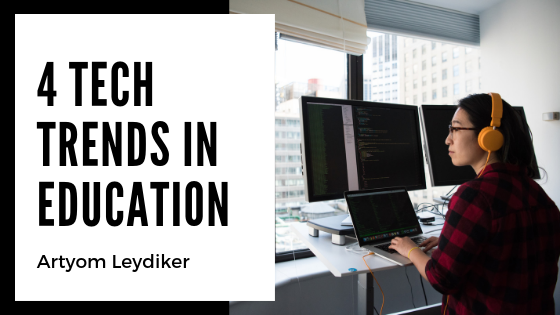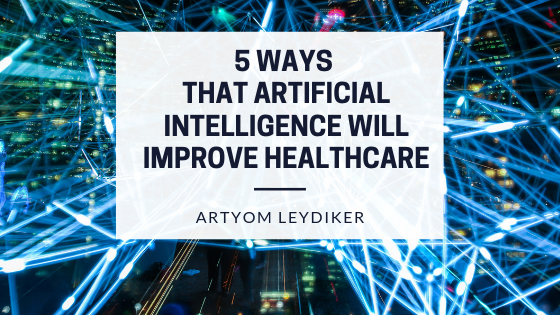About Artyom
Artyom Leydiker has been interested in technology for as long as he can remember. Now more than ever, technology has become a domineering force — both in our individual everyday lives and in global shifts toward change and progress in business, entertainment, education, and much more. Artyom created this blog to share some of the news and trends in technology that inspire him, including but not limited to virtual reality, artificial intelligence, and the rise of blockchain. Check out his blog page for all content, or get started with a few posts below!

4 Tech Trends in Education
The impact of technology occurs across all sectors, including education. As researchers work to make technological advances have more practical implications, those in the education sector are finding ways to integrate technology into schools. These are four of the top trends pushing technology in the classroom.
Virtual Reality
The advent of virtual reality in the classroom aids in active learning for students. Different applications even allow students to participate in learning activities together. Students can explore other countries and times as though they were there in person. With the rise in developing tools for students with special needs, virtual reality can play a role for children with autism. Virtual reality can help these students practice situations and prepare them for classroom learning.
Social Media Use
While social media use still requires caution and supervision, especially for younger children, it can facilitate collaboration in learning. Teachers can make private groups on Facebook to let students talk to each other and share resources. Students and teachers can share relevant news articles or videos. Active social media use also allows parents to interact with teachers and get to know other students in the classroom.
Individual Devices
Instead of banning laptops and tablets in the classroom, many schools now provide individual computers and tablets for students. Rather than spend an hour in the computer lab a day, teachers get to use computers to help students explore key concepts and reinforce materials in class. Researching during class time and playing learning games now take place electronically. Even teachers in high school and college see the value in students taking notes with a laptop over pen and paper.
Machine Learning
The integration of machine learning into the classroom is on the rise. Machine learning allows computer programs to adjust to situations and simulations using data to predict outcomes. In education, machine learning can help learning programs adapt to individual needs by assessing student outcomes and developing a curriculum based on student performance. Computer software can also use data to determine the reminders that students and teachers need to be efficient.
Technology can redefine learning spaces and approaches to teaching. By including technological devices and programs in the classroom, students can submerge themselves into the material. Likewise, teachers have the advantage of integrating data to improve delivery systems. These are some of the top tech trends in education.

5 Ways That Artificial Intelligence Will Improve Healthcare
Experts that study technology and the healthcare industry are seeing the early signs of a massive revolution. This revolution is the introduction of artificial intelligence (AI) into the healthcare sector. While the technology currently driving AI is still in its infancy, it is making huge leaps and strides every year. AI is already being used to create healthcare products, however, it is thought that it will totally control the entire industry in just a few decades.
Understaffing
Hospitals and clinics around the world share a common problem. This problem is understaffing. It is typically caused by budget shortages or a shortage of properly trained professionals. AI-driven applications could easily solve this issue by independently undertaking radiology tasks, diagnosing patients through computer systems, and providing accurate digital consultations. Less healthcare staff shortages are a direct path to better medical care for everyone.
Reducing Antibiotic Resistance
One of the major problems facing the healthcare industry today is increased antibiotic resistance for certain diseases. More than a biological problem, this is a data processing problem. The limitations on current computer processing power and human intelligence inhibit new antibiotics from being created. AI-driven supercomputers could process unfathomable amounts to crack the code on new antibiotic variations that diseases are not resistance to.
Improved Immunotherapy For Cancer
For anyone unfamiliar with immunotherapy, is the process of using the body’s immune system to fight off certain types of cancer. AI could greatly help in improving immunotherapy treatments by conducting highly complex DNA analysis on patients and producing an exact match immunotherapy treatment that is perfectly suited for the individual patient’s genetic makeup.
Wearable AI
In less than a decade most healthcare patients will have wearable monitoring devices driven by AI diagnostic systems. This AI will not only be able to monitor vitals and diagnose health problems, but it will also be able to make lifestyle, dietary, and general health based suggestions.
Improved Clinical Decision Making
In the future, a board of doctors, surgeons, and other healthcare professionals will no longer sit around a table in order to come to a decision on a pressing matter. Instead, AI-powered by supercomputers will propose cutting edge solutions on its own, some of which could be unique treatments never used before. Committees and healthcare boards will then be charged with approving AI proposals, rather than coming up with solutions themselves.
Reedsy / Behance / Twitter / Stumbleupon / Crunchbase / Medium / Slideshare / Soundcloud